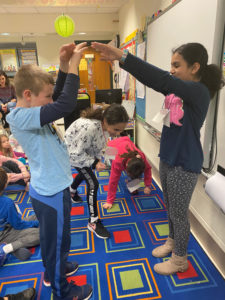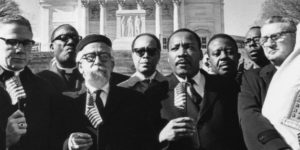Viewing: February, 2020
February 4, 2020
Number the Stars (Day 2 Updates)
 Today, Carly from The Hartford Stage came for our second day of learning about Number the Stars. The kids began by pantomiming several scenes, such as acting in a school play, blowing out the candles on a birthday cake, etc. The kids really enjoyed figuring out how to act out those scenes, especially since these moments were so familiar to them. Following these tableaux, Carly led the students in a safe discussion about what was happening in and around Copenhagen (the setting of the story) in the 1930s. She introduced the concept of the Holocaust, and I was surprised by how much many students already knew. She explained that Hilter looked for someone to blame for the problems happening in Germany and that the Jews were made into scapegoats. She shared that, eventually, many of the Jews were rounded up and sent to camps where many worked and many perished. The kids took this topic seriously, and I admire their maturity during the discussion. I should say that there are times when students have additional prior knowledge and may start to share more sensitive information than what we’d normally choose to include. Carly and I both redirect the conversation when this happens, and we remind kids that some things are best discussed with families at home. This hasn’t happened yet this week. In the event that something particularly sensitive is shared by a student in front of the whole class, I’ll, of course, give you a heads-up so you can be prepared for questions at home.
Today, Carly from The Hartford Stage came for our second day of learning about Number the Stars. The kids began by pantomiming several scenes, such as acting in a school play, blowing out the candles on a birthday cake, etc. The kids really enjoyed figuring out how to act out those scenes, especially since these moments were so familiar to them. Following these tableaux, Carly led the students in a safe discussion about what was happening in and around Copenhagen (the setting of the story) in the 1930s. She introduced the concept of the Holocaust, and I was surprised by how much many students already knew. She explained that Hilter looked for someone to blame for the problems happening in Germany and that the Jews were made into scapegoats. She shared that, eventually, many of the Jews were rounded up and sent to camps where many worked and many perished. The kids took this topic seriously, and I admire their maturity during the discussion. I should say that there are times when students have additional prior knowledge and may start to share more sensitive information than what we’d normally choose to include. Carly and I both redirect the conversation when this happens, and we remind kids that some things are best discussed with families at home. This hasn’t happened yet this week. In the event that something particularly sensitive is shared by a student in front of the whole class, I’ll, of course, give you a heads-up so you can be prepared for questions at home.
Toward the end of the activity, students thought about what sounds they’d hear in a war zone. Ideas included explosions, gun shots, car engines roaring, people shouting, etc. Students made a “sound circle” where they created a cacophony of the sounds they’d expect to hear during a time of war. Finally, one group of four students recreated the previous tableaux of those familiar moments, but this time, with the “soundtrack” of the sound circle. This helped the kids to imagine how so many of these familiar moments would be different during wartime. Kids shared how they’d feel if they had to live during these situations, and their comments were deep. As I said in a previous message, these students don’t have much understanding of ideas like war, persecution, or hatred, and activities like these help them to understand these concepts a bit better.
Following these activities, I always remind students of a few things: (1) They are completely safe. We’re studying events from our world’s history, and by learning about them, we can work to ensure that they never happen again. But they are absolutely safe in their homes, school, and community. (2) These topics should be discussed when there’s an adult there to facilitate the conversation. So this isn’t appropriate conversation for the lunchroom, playground, bus, etc. (3) There are some things that might be upsetting or alarming. Kids can always come to me if they’re feeling worried or anxious, and they can talk to their grownups at home as well.
Posted in Class Updates|By Jon Moss
February 2, 2020
Learning About Civil Rights
 Martin Luther King Day is such an important day in our country, and in our class, it kicked off our informal unit about Civil Rights. On the Friday before Martin Luther King Day, we read the first half of a wonderful book called As Good As Anybody. This book tells the story of Martin Luther King Jr., starting from his life as a young boy. It gave us a wonderful opportunity to talk about the concepts of discrimination, segregation, separate-but-equal (and the inherent flaw in that idea) and more. I’m always glad to see how confused kids are by this – The idea of treating someone unkindly because of their skin color was totally alien to the kids, and they couldn’t fathom how someone would do this to another person. This launched us into our continuing study of diversity and civil rights.
Martin Luther King Day is such an important day in our country, and in our class, it kicked off our informal unit about Civil Rights. On the Friday before Martin Luther King Day, we read the first half of a wonderful book called As Good As Anybody. This book tells the story of Martin Luther King Jr., starting from his life as a young boy. It gave us a wonderful opportunity to talk about the concepts of discrimination, segregation, separate-but-equal (and the inherent flaw in that idea) and more. I’m always glad to see how confused kids are by this – The idea of treating someone unkindly because of their skin color was totally alien to the kids, and they couldn’t fathom how someone would do this to another person. This launched us into our continuing study of diversity and civil rights.

Leaders of the protest, holding flags, from left Bishop James Shannon, Rabbi Abraham Heschel, Dr. Martin Luther King and Rabbi Maurice Eisendrath.” Tomb of the Unknown Soldier, Arlington Cemetery, February 6, 1968. Published February 7, 1968. (Photo by Charles Del Vecchio/Washington Post/Getty Images)
This past Friday, we finished reading As Good As Anybody. The second half of the book taught us about Abraham Joshua Heschel, a Jewish man who fought for the rights of Jews who were being persecuted, much as Dr. King did for African Americans. The two men teamed up and worked together to accomplish their shared goal of earning equal civil rights and fair treatment for ALL.
While the kids were, of course, familiar with Dr. King, Abraham Joshua Heschel was a new name to them. The book hints at how Jews were treated unjustly in Europe during World War II, and it lets us add to our previous understanding of discrimination by race or gender by understanding the idea of discrimination by religion. This transitions perfectly to an activity we’re starting this Monday.
On Monday, fourth graders at PGS will start a unit of study about an incredible novel called Number the Stars. Throughout the week, theater educators from the Hartford Stage will join our class to teach the kids about the novel Number the Stars, which tells the story of a fictional family in Denmark that helps to hide a Jewish family that tries to escape from the Nazis during the Holocaust. Following the Hartford Stage residency, we will begin reading this novel as a class.
This will be an advanced unit that touches on mature content matter. Fourth graders at PGS have had this unit for many years, and I’m always impressed by how maturely students are able to participate in the lessons.
When we teach this unit, our focus is more on characters and situations in the novel, with general background information provided to students. We do NOT discuss any of the graphic or gory details of the Holocaust, and we always work very hard to make the unit “kid-friendly” and age-appropriate for fourth graders. We focus more on challenges that characters faced and understanding the feelings they had, rather than the facts of what took place during the time period (although some general ideas are introduced during the unit). Think of it as a book that takes place during the Holocaust, not a book about the Holocaust itself.
As the unit progresses, I will be in contact with you to keep you informed about class discussions and content so that you can be prepared for follow-up discussions at home. And as always, if you have any questions or concerns, please feel free to email me.
Posted in Class Updates|By Jon Moss
